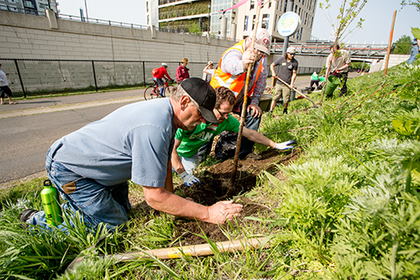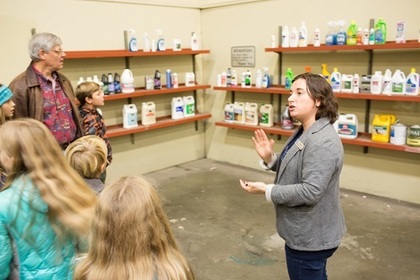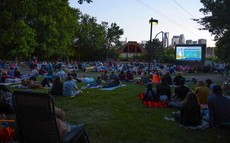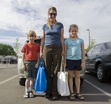|
ABOUT GREEN NOTES
GreenNotes covers environmental news, programs and events from Hennepin County.
Please take a few moments to read our stories. Share your feedback and ideas for protecting the environment.
Get a link for sharing Green Notes in email and social media by checking out the archived issues.
Email Hennepin Environment
Please forward this email to interested individuals and encourage them to sign up.

|
Hennepin County had great year working with our many partners to protect and improve the environment. Before we say farewell to 2016, check out some of our highlights and accomplishments.
Encouraged waste reduction, recycling and improved waste management

- Launched the Zero Waste Challenge, in which we’re working with 40 families to try new waste reduction actions and report on the amount of waste they generate for a year.
- Celebrated the 4-year anniversary of the Fix-It Clinic program and hosted our 50th clinic. More than 3,500 items have been fixed since the program started.
- Awarded more than $657,000 in grants to 75 businesses, nonprofits and schools to reduce waste, increase recycling and start organics recycling.
- Provided on-site recycling assistance at nearly 70 apartment/condo buildings or townhome communities.
- Developed public outreach materials for the City of Minneapolis to help them recruit more participants in their residential organics recycling program. More than 40 percent of households are now participating.
- Conducted a waste sort study that found increasing organics recycling, preventing food waste, recycling more paper and cardboard and using drop-off options for materials not collected at home are our best opportunities to reduce waste.
- Made improvements at the Hennepin Energy Recovery Center (HERC) to reduce nitrogen oxide emissions, increase efficiency of the facility’s operations, and reduce the plume of water vapor that is released from the cooling tower.
Protected land and water

- Adopted the county’s first Natural Resources Strategic Plan to guide the county in responding to natural resource issues and developing policies, programs and partnerships that improve, protect and preserve natural resources.
-
Planted trees of 24 different species from the county’s gravel-bed nursery at county buildings and along paths and roads. Expanded the county’s gravel-bed nursery, worked with North High School students to establish a gravel-bed nursery and transplant trees on the school property, and established an urban orchard at the Hennepin County human services center in Brooklyn Center.
- Prevented the spread of aquatic invasive species by increasing inspections at boat accesses, implementing education campaigns, training the public, conducting milfoil and zebra mussel research and studying alternative pathways of introduction, such as pet stores and plant nurseries.
- Supported the cleanup of contaminated properties by awarding more than $2.2 million through 17 Environmental Response Fund grants.
- Funded eight natural resources grants to install a variety of best management practices including ponds that filter stormwater, rain gardens, pollinator gardens, permeable pavers, green roofs and stormwater cisterns, as well as restore stream banks and shorelines.
Properly disposed of hazardous waste
- Helped 30,000 visitors find information on the best way to recycle, reuse or dispose of household items with the Green Disposal Guide. The guide received an award for outstanding achievement in web development from the Web Marketing Association.
- Collected household hazardous waste and recycling from more than 124,000 residents at the Hennepin County Drop-off Facilities.
- Collected over 22,000 pounds of medicines at drop boxes in partnership with the Hennepin County Sheriff’s Office. Supported the Osseo and Golden Valley police departments in adding medicine drop-boxes and visited 33 senior living facilities to collect medicines.
- Launched online training for businesses that generate hazardous waste to help them better understand hazardous waste rules and management.
Provided environmental education

- Promoted reuse, recycling and actions to protect water through the Choose to Reuse, Recycle Everywhere and Clean Water Minnesota campaigns.
- Updated environmental education activity guides and learning trunks that educators can use to engage audiences of all ages in learning about and taking action to protect the environment.
- Helped 44 organizations engage more than 50,000 residents in learning about environmental issues and taking action to protect the environment through the Green Partners environmental education grants program.
- Gave tours of the Brooklyn Park Drop-off Facility and the Hennepin Energy Recovery Center to help 1,800 residents better understand the journey waste goes through and what they can do to reduce waste.
- Planned NatureFest, an environmental education field day for more than 400 fifth graders at the Three Rivers Park District’s Coon Rapids Dam Regional Park.
- Engaged volunteers, including more than 90 citizen scientist volunteers who monitor water quality, 85 Fix-it Clinic volunteers, and 350 Master Recycler/Composters.
 Funding is available for projects that prevent the spread of aquatic invasive species (AIS). Eligible project activities include enhancing early detection efforts, increasing education, expanding inspections and supporting research.
|
A few project examples include:
- The Minneapolis Park and Recreation Board used a 2016 Hennepin County AIS grant to create short AIS prevention public service announcements (PSAs) that were aired during their Music and Movies in the Parks series. The PSAs aired at 53 movies with a total attendance of more than 17,800 people.
- The Three Rivers Park District used a $30,000 Hennepin County AIS grant to increase watercraft inspections and education by 43 percent at six lakes, including conducting inspections for the first time at Twin Lake and Little Long Lake. More than 6,500 inspections were conducted and 130 contaminated watercraft were found.
See the 2016 accomplishments report for more project examples and an update on the county’s AIS prevention efforts. Applications for 2017 AIS grants are due by January 20, 2016. Learn more and apply.
For more information, contact Tony Brough at tony.brough@hennepin.us or 612-348-4378.
 Sun Country Airlines recently started organics recycling on their airplanes with the help of a Hennepin County business recycling grant. Materials including coffee grounds, cups, napkins and leftover food are collected for composting.
This effort is part of the airlines’ broader Soaring to Sustainability initiative that aims to reduce their footprint and conserve natural resources. Sun Country also used part of their $24,600 grant to improve recycling on their airplanes and in their office buildings located at the Minneapolis-St. Paul airport. Grant funding covered the costs for a startup supply of compostable bags, organics and recycling bins, and the first three months of organics recycling hauling.
Hennepin County accepts applications from smaller business recycling grants anytime, and the next deadline for larger grants is February 15, 2017. Learn more.
For more information, contact Andre Xiong at andre.x.xiong@hennepin.us or 612-543-1316.
|
 The New Year can be a great time to make changes to live a more environmentally friendly lifestyle. But be sure to make a plan to help you put your resolutions into action. Take the following steps:
|
-
Choose an action: Whether you want to reduce or eliminate your use of a specific item (maybe paper towels or plastic bags), start composting in your backyard, or keep leaves out of the street and storm drains, be sure to choose a specific behavior that you can realistically take action on.
-
Think about your barriers and motivations: Consider what stands in the way for you and others in your household from taking this action and why you would take action. Use this information to help you identify ways to overcome your challenges and build on your motivations.
-
Identify what you need to take action: Get any supplies, information or prompts you need to take your chosen action.
-
Set a goal and timeframe: Set a specific goal for what you are trying to achieve, decide exactly when you are going to take action, and determine if and how your will track your progress.
-
Celebrate your successes: Recognize when you achieve your goal, take a moment to celebrate, and build on your successes to plan your next action.
Not sure where to start?
Here are some ideas for actions you can take now to get you started:
- Get your broken household items fixed and learn repair skills by attending a Fix-It Clinic.
- Think about what you’re going to be buying in the New Year and if there are ways to reduce, borrow, or shop reused instead of buying new.
- Improve recycling in your household by ordering supplies to make it clear what materials go in what bin.
- Find the best disposal options for things you are getting rid of by checking the Green Disposal Guide.
- Reduce the number of hazardous chemicals you use in your home by making your own from simple ingredients.
- Protect water quality by reducing salt use and practicing environmentally friendly snow and ice care this winter.
|